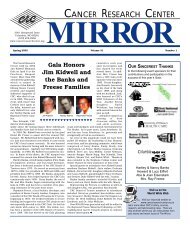2010 Annual Report - Cancer Research Center
2010 Annual Report - Cancer Research Center
2010 Annual Report - Cancer Research Center
You also want an ePaper? Increase the reach of your titles
YUMPU automatically turns print PDFs into web optimized ePapers that Google loves.
Current <strong>Research</strong><br />
Deeming our research worthy to procede beyond lab-cultured cells, this approval was a major victory<br />
and milestone on the way to human clinical trials. We acquired mouse facilities at the University of Missouri<br />
Columbia and determined safe and effective dosage levels to treat the primary and secondary tumors<br />
TRAMP mice develop. We were excited to find that the TRAMP mice easily tolerated doses of over 100<br />
million therapeutic CRC2631 bacteria. In contrast, just 10 non-therapeutic or Salmonella as found in the<br />
wild will kill a mouse within three days.<br />
Following promising toxicity trials we turned our attention to tracking the bacteria in the mouse. Testing<br />
which carried over into 2008 repeatedly showed that within 24-48 hours our therapeutic Salmonella<br />
was eliminated from the body of TRAMP mice and only retained in the tumor. We also continued to see<br />
CRC2631 target cancer cells 1,000 times over normal cells in the mouse even as we made genetic changes<br />
to fine-tune the bacteria’s performance.<br />
In 2009, we developed dosage protocols and conducted therapeutic studies to determine the dosage of<br />
CRC2631 therapeutic Salmonella to give to the TRAMP mice to inhibit, reduce, and/or eliminate their tumors.<br />
Normally, TRAMP mice do not make it to one year of age due to their predisposition to produce large<br />
prostate tumors at a young age (3-6 months). The goal is to have them live to a ripe old age, which for this<br />
species of mice is about two years. These studies continued into <strong>2010</strong>.<br />
A second critical objective was reached in 2009 with the development of a quantitative assay to measure<br />
the number and type of cancerous cells that our therapeutic Salmonella preferentially attack. Using a Fluorescence<br />
Activated Cell Sorting (FACS) system we are able to count individual cancer cells and determine<br />
how effectively our bacterial therapy attaches and destroys them. This new assay helps us identify bacterial<br />
strains with improved cancer-targeting capabilities and to determine exactly how proficient the bacteria<br />
are at targeting different types of cancer. We now use this system to identify strains with enhanced cancertargeting<br />
capabilities and will use it to screen for strains attracted to other cancer types such as melanoma,<br />
pancreatic, breast and colon.<br />
Senior Investigator Dr. Robert Kazmierczak and Senior Technician & Laboratory Manager<br />
Alison Fea<br />
A year in review <strong>2010</strong> 11



